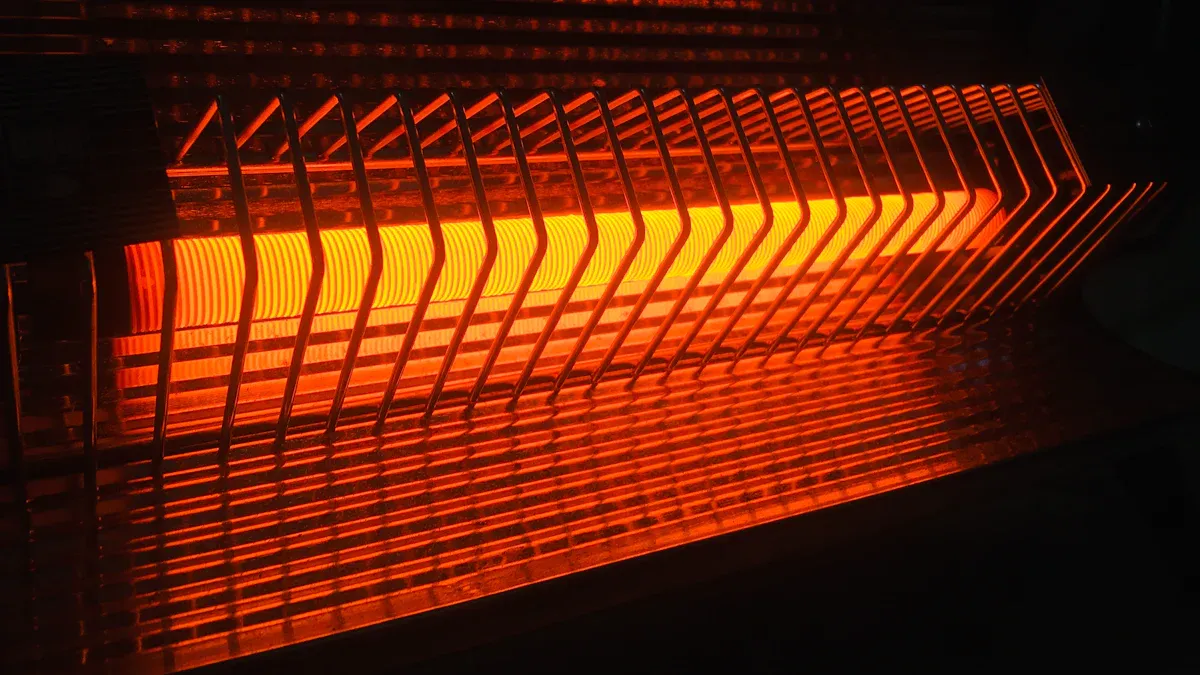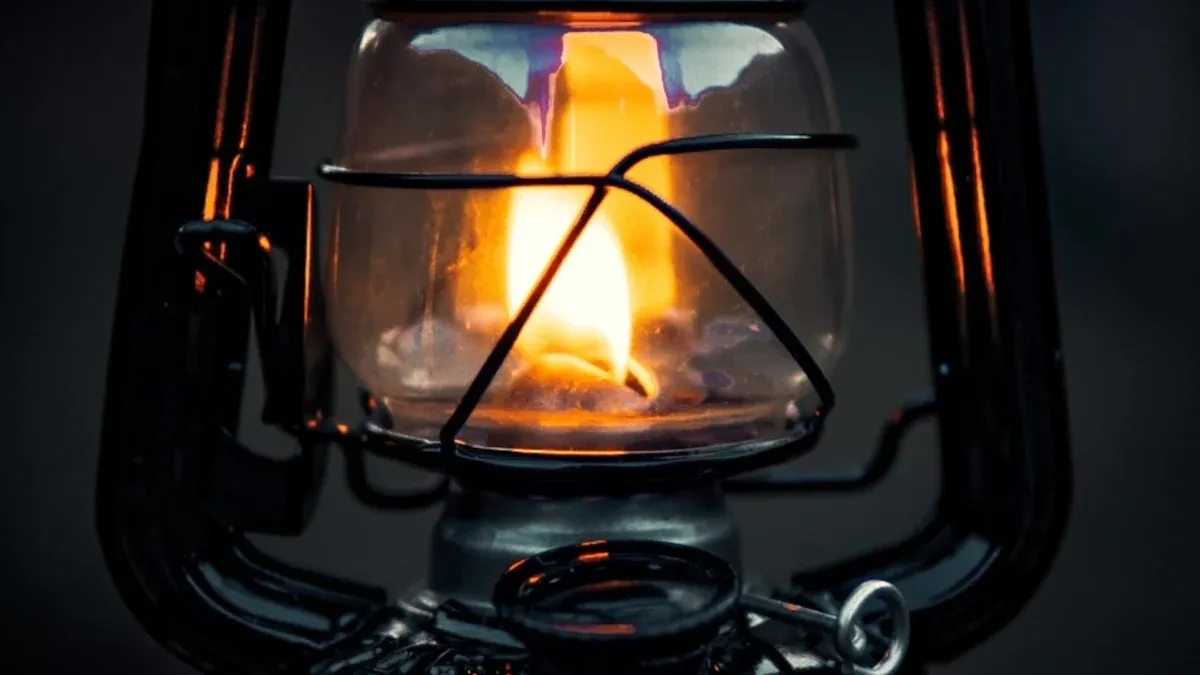Views: 0 Author: Site Editor Publish Time: 2025-07-09 Origin: Site









You want a heating lamp that keeps you safe, saves energy, and lasts a long time. Infrared Heating Lamp technology stands out as the safer and more reliable choice. These lamps deliver up to 30–50% energy savings and require fewer replacements than traditional heat lamps. Many people choose Fast Medium Wave Infrared Lamp models for their durability and minimal maintenance. If you wonder Why Infrared Heating? The Power of White Coating often boosts efficiency and heat delivery, making these lamps a smart investment for homes and businesses.
Infrared heating lamps warm objects quickly and use up to 50% less energy than traditional heat lamps.
Infrared lamps have safer surfaces and built-in protections, reducing burn and fire risks compared to traditional lamps.
Infrared lamps last longer and need less maintenance, saving time and money over traditional heat lamps.
Infrared heating produces gentle, invisible heat that does not stir up dust or disturb sleep, making it better for allergies and night use.
Choose infrared lamps for large spaces, energy savings, and health benefits; traditional lamps may suit small areas needing quick, local warmth.

You often see traditional heat lamps in bathrooms, food warmers, and animal enclosures. These lamps use a filament, usually made of tungsten, inside a glass bulb. When you turn on the lamp, electricity heats the filament. The lamp then gives off both light and heat. Most of the heat spreads through the air, so the lamp warms up the space around it. This method can take longer to heat a room or object. Traditional heat lamps usually have a limited range of power and size. You may notice that these lamps do not always heat evenly, and they can waste energy by warming the air instead of specific objects.
An Infrared Heating Lamp works differently. Instead of heating the air, it sends out infrared waves that directly warm up objects and surfaces. You feel the heat almost instantly, usually within one or two seconds. These lamps use quartz glass tubes and high-temperature alloy filaments, which help them last longer and provide more uniform heating. You can find Infrared Heating Lamp models in many sizes and power levels, making them useful for homes, businesses, and even industrial settings. They offer precise temperature control and do not release hazardous byproducts or greenhouse gases.
Tip: If you want fast, targeted heating with less energy loss, consider an Infrared Heating Lamp.
Here is a quick comparison to help you see the main differences:
Feature / Specification | Infrared Heating Lamps | Traditional Heat Lamps |
|---|---|---|
Heating Response Time | Very fast (1-2 seconds to full power) | Slower, cannot achieve rapid heating |
Heating Uniformity | More uniform heating on both sides of materials | Less uniform heating |
Energy Efficiency | Higher efficiency, direct radiation with less energy loss | Lower efficiency, heat transfer via air |
Safety | Safer, no hazardous byproducts or greenhouse gases | May produce hazardous byproducts |
Temperature Control | Precise, adjustable output power from 0 to rated power | Less precise control, slower response |
Working Life | Long working life due to quartz and alloy filaments | Shorter life span |
You can see that Infrared Heating Lamp technology offers faster, more efficient, and safer heating compared to traditional heat lamps. This makes it a strong choice for many modern applications.

When you choose a heating lamp, safety comes first. Traditional heat lamps get very hot on the surface. If you touch the bulb or the metal guard, you can burn your skin in seconds. These lamps often sit close to people, pets, or flammable materials. This setup increases the risk of accidental burns and even fire. You must always keep a safe distance and never leave these lamps unattended.
Infrared Heating Lamp models work differently. They heat objects and surfaces directly, not the air. The lamp itself does not always get as hot as a traditional bulb. You feel the warmth on your skin, but the risk of burns from touching the lamp is lower. Many designs include safety covers or cool-touch housings. These features help prevent accidents. You still need to use caution, but you get a safer experience overall.
Note: Always install any heating lamp according to the manufacturer's instructions. Proper placement reduces the risk of fire and injury.
Both types of lamps use electricity, so you need to think about electrical safety. Traditional heat lamps often use higher wattages. This can strain old wiring or overload circuits. If moisture gets into the socket, you face a shock hazard. You must check cords and sockets for damage before each use.
Infrared Heating Lamp units usually run at lower wattages for the same amount of heat. This means less stress on your electrical system. Many models come with built-in safety features like automatic shut-off or overheat protection. These features add another layer of safety for you and your family.
Health impacts also matter. Traditional heat lamps give off bright, visible light. This can bother your eyes or disrupt sleep if you use them at night. The heat they produce moves through the air, which can stir up dust and allergens. If you have allergies or asthma, this can make symptoms worse.
Infrared Heating Lamp technology produces gentle, invisible infrared waves. You do not see harsh light, so your eyes stay comfortable. The heat does not move air around, so you avoid spreading dust or allergens. This makes infrared a better choice for people with respiratory issues.
Here is a quick safety checklist for both lamp types:
Traditional Heat Lamps
High surface temperature
Fire risk if placed near flammable items
Bright light may disturb sleep
Can stir up dust and allergens
Infrared Heating Lamps
Lower surface temperature
Built-in safety features common
No harsh light emission
Less air movement, better for allergies
Tip: If you want a safer, healthier heating option, consider switching to an infrared model.
When you invest in a heating lamp, you want it to last. Traditional heat lamps often use glass bulbs and metal filaments. These parts can break or wear out quickly, especially if you use the lamp every day. Small bumps or drops may crack the bulb or damage the filament. You might notice that these lamps lose brightness or stop working after a few months of heavy use.
Infrared Heating Lamp models use quartz glass tubes and high-quality alloy filaments. Quartz resists heat and sudden temperature changes better than regular glass. The alloy filament inside does not burn out as fast as tungsten. You can expect these lamps to handle frequent use and even minor impacts without breaking. Many users report that their infrared lamps work for years with little trouble.
Tip: Choose a lamp with a quartz tube if you want the best durability for daily use.
You want a heating solution that does not need constant attention. Traditional heat lamps often require you to replace bulbs or clean dust from the surface. Dust buildup can cause the lamp to overheat or even catch fire. If you use the lamp in a kitchen or animal area, grease and dirt may collect on the bulb, making cleaning even more important.
Infrared Heating Lamp units need less maintenance. The quartz tube stays cleaner and resists dust buildup. You do not have to replace the filament as often. Most models only need a quick wipe with a dry cloth every few months. You save time and money because you do not need to buy new bulbs or spend hours on upkeep.
Here is a quick look at maintenance needs:
Lamp Type | Maintenance Frequency | Common Tasks |
|---|---|---|
Traditional Heat Lamp | Every 1-3 months | Bulb replacement, cleaning |
Infrared Heating Lamp | Every 6-12 months | Light dusting, inspection |
Note: Always unplug your lamp before cleaning to avoid electric shock.
You want your heating lamp to work the same way every time you turn it on. Traditional heat lamps can lose power as the filament ages. You may notice that the lamp takes longer to heat up or does not get as warm as before. Frequent on-off cycles can shorten the life of the bulb and make the lamp less reliable.
Infrared Heating Lamp technology gives you steady performance over time. The quartz tube and alloy filament keep working at full strength for thousands of hours. You get the same level of heat from the first day to the last. Many models include built-in sensors that keep the temperature stable, so you do not have to worry about sudden drops or spikes in heat.
Callout: If you want a lamp that delivers reliable heat year after year, infrared models offer the best performance consistency.
Mold and Condensation Prevention
One hidden perk of infrared heating lamps is their ability to keep mold and condensation at bay. Unlike traditional heat sources that simply warm up the air, infrared lamps heat objects, walls, and floors directly. This means those surfaces stay dry and less hospitable to mold growth.
Because infrared lamps do not create air circulation like a fan or blower would, they avoid spreading moisture and do not push humid air into cooler corners. The gentle, even warmth helps prevent damp spots where condensation can collect—a common troublemaker in poorly ventilated rooms, bathrooms, or basements.
You also do not have to worry about these heaters creating pockets of excessive warmth that can clash with cold air and lead to water droplets on surfaces. Instead, infrared heating keeps everything comfortably dry and reduces the chance for mold to take hold.
Fact: If you struggle with mold or recurring condensation, switching to an infrared heating lamp can make your space healthier by keeping walls and surfaces dry.
You want a heating solution that uses energy wisely. An Infrared Heating Lamp converts up to 96% of its energy into radiant heat. This means almost all the electricity you use goes straight into warming people and objects, not just the air. You feel the warmth quickly and directly. Because these lamps heat surfaces and not the air, you waste less energy, especially in rooms with poor insulation or high ceilings. You also save money over time. Many users report over 30% lower energy bills compared to traditional heating systems. You do not need to worry about gas costs, and you avoid the dry air and dust that come with other heaters. After you turn off the lamp, the heat lingers, so you stay comfortable longer.
Tip: Infrared heating works best in spaces where you want fast, targeted warmth—like bathrooms, workshops, or patios.
Traditional heat lamps work differently. They convert only about 50% of their energy into usable heat. Most of the energy heats the air, which can escape quickly, especially in large or drafty rooms. You may notice uneven heating, with warm spots near the lamp and cooler areas farther away. These lamps often require more power to achieve the same comfort level as infrared models. You might also face higher installation and maintenance costs, since traditional systems sometimes need professional help. The heat disappears soon after you turn off the lamp, so you may need to run it longer to stay warm.
Here is a quick comparison to help you see the differences:
Aspect | Traditional Heat Lamps | Infrared Heating Lamps |
|---|---|---|
Energy Conversion Efficiency | About 50% | Up to 96% |
Heating Method | Heats air by convection | Directly heats objects and people |
Energy Waste | High | Low |
Energy Cost Savings | Baseline | Over 30% savings |
Heat Retention After Shutdown | Heat dissipates quickly | Heat lasts longer |
Installation & Maintenance | Professional help often needed | Easy setup, little maintenance |
Note: For large, open rooms or poorly insulated spaces, infrared heating often provides better comfort and lower costs.
Infrared Heating Lamps vs. Air Conditioners and Heat Pumps
Wondering how infrared heating stacks up against air conditioners with heat pump functions? It’s a smart comparison—especially if you’re trying to stay comfortable and energy-savvy through winter’s chill.
Unlike heat pumps, which can struggle to warm rooms effectively when the outside temperature drops near freezing (think 0°C or below), infrared heating lamps deliver consistent warmth regardless of outdoor conditions. That’s because infrared models don’t rely on pulling heat from outside air—they generate radiant heat that warms people and surfaces directly. No waiting for a unit to “catch up” on a frosty morning.
Another key advantage: infrared heaters avoid the issues that can come with air conditioning units, like circulating dust and tiny particles, especially if the AC filter isn’t clean. Traditional forced-air systems can stir up allergens or even contribute to mold growth during damp, cold weather. Infrared lamps bypass this problem entirely. They don’t use fans, so they don’t blow around dust or drafts. The result? Cleaner air and a reduced risk of winter mold.
In short, if you want warmth that’s reliable—no matter how cold it gets outside—and healthier air inside, infrared heating lamps make a solid alternative to your standard AC heat pumps.
You can use the table below to quickly compare the main features of traditional heat lamps and infrared heating lamps. This table helps you see which lamp fits your needs best.
Feature | Traditional Heat Lamp | Infrared Heating Lamp |
|---|---|---|
Heating Speed | Slow | Very fast |
Energy Efficiency | Moderate | High |
Surface Temperature | Very hot | Lower, safer |
Light Emission | Bright, visible | Gentle, often invisible |
Maintenance | Frequent bulb changes | Minimal upkeep |
Lifespan | Shorter | Longer |
Allergy Friendliness | Can stir up dust | Does not move air |
Cost Over Time | Higher | Lower |
Tip: Use this table as a checklist when you shop for a new heating lamp.
You want to pick the lamp that matches your space and lifestyle. Here are some tips to help you decide:
Small rooms or bathrooms: Choose a traditional heat lamp if you want quick, local warmth and do not mind bright light.
Large or open spaces: Pick an infrared model for fast, even heating and better energy savings.
Nighttime use or light sensitivity: Go with an infrared lamp. It gives off less visible light and will not disturb your sleep.
Allergy or asthma concerns: Select an infrared lamp. It does not move air or dust, so you breathe easier.
Budget: If you want lower long-term costs, invest in an infrared lamp. You will save on energy bills and maintenance.
Frequent use: Choose an infrared lamp for longer lifespan and fewer replacements.
If you still feel unsure, ask a heating professional for advice. Your comfort and safety matter most.
You now know that infrared heating lamps offer greater safety and reliability. These lamps use less energy, last longer, and reduce risks like burns or allergies. For large rooms, allergy concerns, or nighttime use, choose an infrared lamp. In small spaces or for quick warmth, a traditional lamp may work.
Always match your lamp choice to your needs. If you feel unsure, ask a heating expert for advice.
Yes, you can use infrared heating lamps in bedrooms. These lamps do not emit harsh light. You get gentle, quiet warmth without disturbing your sleep. Always follow safety guidelines for installation and placement.
No, you usually spend less on energy with infrared heating lamps. These lamps convert more electricity into heat. You save money over time because they use less power and last longer.
Infrared heating lamps offer safer surfaces and lower burn risks. Many models have cool-touch housings. You still need to keep children and pets from touching any heating device.
You only need to wipe the quartz tube with a dry cloth every few months. Always unplug the lamp before cleaning. You do not need to replace bulbs often.
You can use some traditional heat lamps outdoors, but you must check for weatherproof ratings. Infrared heating lamps work better outside because wind does not blow the heat away.
content is empty!

